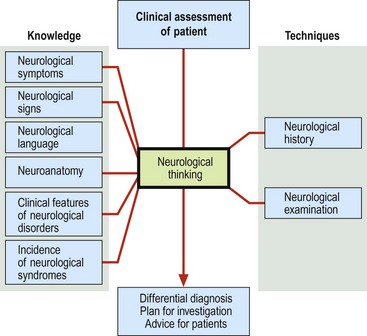Neurological thinking
How does an experienced clinical neurologist come to a clinical diagnosis? Considering how this is done helps to appreciate the knowledge and skills that are needed and to understand how they are applied.
The process of diagnosis involves:
 Background knowledge of neurological symptoms and signs, the clinical features of neurological syndromes and diseases, neuroanatomy and an appreciation of the incidence of different neurological syndromes.
Background knowledge of neurological symptoms and signs, the clinical features of neurological syndromes and diseases, neuroanatomy and an appreciation of the incidence of different neurological syndromes. The techniques of taking a neurological history and conducting a neurological examination. The techniques that are used will depend on the patient’s problem and different approaches will be used in different clinical settings.
The techniques of taking a neurological history and conducting a neurological examination. The techniques that are used will depend on the patient’s problem and different approaches will be used in different clinical settings.Making a neurological diagnosis
There are two ways of making a neurological diagnosis clinically.
‘Wiring diagram analysis’ or anatomical localization
This process is led by the history but is primarily a synthesis of findings on clinical examination. In trying to make sense of the physical signs, one should think about which level of the nervous system is being affected (p. 2). The onset and progression of the anatomically determined symptoms reflect the underlying pathology; this information is taken from the history, and is discussed further on pages 8–9.





